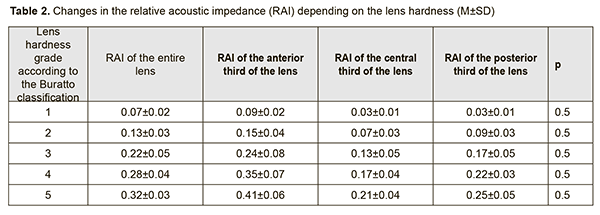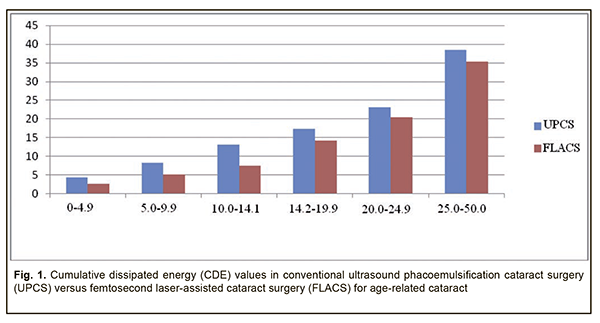J.ophthalmol.(Ukraine).2018;4:3-6.
|
https://doi.org/10.31288/oftalmolzh2018436 Received: 11 June 2018; Published on-line: 31 August 2018 Differential approach to the use of femtosecond laser in age-related cataract surgery in eyes with different lens density N.V. Pasyechnikova, Dr. Sc. (Med), Prof, S.K. Dmytriiev, Dr. Sc. (Med), Prof, I.A. Grytsenko, MD Filatov Institute of Eye Diseases and Tissue Therapy; Odessa (Ukraine) E-mail: awsed2005@ukr.net TO CITE THIS ARTICLE: Pasyechnikova NV, Grytsenko IA, Dmytriiev SK. Differential approach to the use of femtosecond laser in age-related cataract surgery in eyes with different lens density. J.ophthalmol.(Ukraine).2018;4:3-6. https://doi.org/10.31288/oftalmolzh2018436
Background: The femtosecond laser provides a new approach to cataract surgery. The efficacy of femtosecond laser-assisted lens fragmentation depends on mechanical lens density and effective fragmentation is important in the management of patients with age-related cataract. Purpose: To determine the differential indications for femtosecond laser-assisted cataract surgery (FLACS) for age-related cataract patients with different lens densities. Materials and Methods: One hundred and ten patients (120 eyes) who underwent cataract surgery using either conventional ultrasound phacoemulsification cataract surgery (UPCS; 55 patients) or FLACS (55 patients) were prospectively followed up. Results: Laser-assisted lens fragmentation was most effective in eyes with a predicted cumulative dissipated energy (CDE) of 10.0 to 14.1 units, allowing for a 5.7 unit (43.4%) decrease in actual CDE compared to the use of conventional phacoemulsification. Conclusion: The use of femtosecond laser in age-related cataract surgery is most effective in eyes with a soft lens nucleus. Keywords: cataract, ultrasound phacoemulsification cataract surgery, femtosecond laser-assisted cataract surgery, cumulative dissipated energy
Introduction Cataract surgery is one of the most dynamic fields in ophthalmology, and developing and translating into clinical application, cutting-edge and innovative, diagnostic and surgical tools to this field is important. The use of femtosecond laser in cataract surgery based on standardization of key stages of the surgical procedure allows ophthalmologists to decrease the risk of intraoperative and postoperative complications. While some consider that femtosecond laser-assisted lens fragmentation was effective for lenses of any density [1], others found that it was most effective for those of grade 1 to 3 density (according to the Buratto classification, LOCS III) [2]. Current classifications are subjective and do not provide the ophthalmologist with the ability to comprehensively and quantitatively assess preoperative lens density with a high level of accuracy. The purpose of the study was to determine the differential indications for femtosecond laser-assisted cataract surgery (FLACS) for age-related cataract, taking into account the acoustic impedance of different layers of the lens. Materials and Methods One hundred and ten patients (120 eyes; age, 48 to 76 years; mean age, 64.6 years; 68 (61.8%) men and 42 women (38.2%)) who underwent cataract surgery using either conventional ultrasound phacoemulsification cataract surgery (UPCS; 55 patients) or FLACS (55 patients) were prospectively followed up. Patients with concomitant ocular disease were excluded. The comprehensive eye examination included autorefractometry (Huvitz MRK-3100 Huvitz Co. Ltd, GoonPoh-Si, South Korea), slit-lamp biomicroscopy (SL-200), Maklakov applanation tonometry, intraocular lens power calculation based on biometric measurements taken by the LENSTAR LS 600 Biometer (Haag-Streit, Koeniz Switzerland), ultrasound biometry (OcuScan RxP; Alcon Laboratories Inc, Irvine, CA; in case of diffuse lens opacification), corneal topography (TMS-4, TOMEY Corp., Nagoya, Japan), electron microscopy and ophthalmoscopy. Ultrasound biomicroscopy of the posterior eye was performed using a Quantel Medical Aviso UBM unit (Quantel Medical, Clermont-Ferrand, France) to obtain sagittal and transverse B-mode ultrasound images, and the acoustic impedance of different layers of the lens was measured. The acoustic echogenicity of different layers of the lens was assessed. Ultrasounds scans were recorded and processed to get color-coded acoustic echogenicity images for densitometry analysis (Patent of Ukraine No.93,206; 2014). We have found previously that the anterior third of the lens demonstrated the greatest association between the optic lens density and acoustic lens density (R=+0,75) [3]. Measurements were performed by one examiner using one device. All the instruments used were calibrated and found appropriate for the study. The hardness of the nucleus was graded according to the Buratto classification scheme with grades from 1 (very pale gray color) to 5 (brown color, with all the tones ranging from amber to black). Maturity stages were graded into mild, immature and mature based on the grading system described by Fyodorov et al. Patients were given topical non-steroidal anti-inflammatory (diclofenac 0.1%; Uniclofen; Unimed Pharma Ltd., Bratislava, Slovakia) and antibacterial (moxifloxacin 0.5%; Vigamox®, Alcon Couvreur NV, Puurs, Belgium) preparations the day before and the day of surgery. Anticholinergic agents (atropine sulphate and cyclopentolate hydrochloride 1%) were used to achieve maximal mydriasis. All surgeries were performed by a single surgeon using a standardized methodology, with the parameters specified through the interface of the Infiniti Vision System (Alcon Laboratories, Inc, Fort Worth, Texas). In addition, the LenSx laser system (Alcon) and OPMI Lumera T microscope (Carl Zeiss Meditec AG, Jena, Germany) were used. Nuclear fragmentation was performed using the phaco-chop technique in all cases. The programmed nuclear fragmentation size was 5.0 mm in all FLACS eyes. Energy used for each femtosecond laser-assisted step of cataract surgery (capsulotomy, primary incision, secondary incisions and nuclear fragmentation) was 5.0 mJ. The grid fragmentation pattern was used. The cumulative dissipated energy (CDE) was recorded from the display on the phacoemulsification machine at the end of surgery and taken into account to assess the lens density. We have found previously [4] an association between the CDE and acoustic impedance in different layers of the lens, and, in the current study, we used previous findings to predict the CDE value for UPCS cases. Results and Discussion Patients were divided into two equal groups based on the type of cataract surgery used (Table 1): conventional UPCS (Group 1; 60 eyes) and FLACS (Group 2; 60 eyes).
The CDE depends on the laser fragmentation pattern, and served as a laser fragmentation efficiency marker. Previously, we have shown correlations between the CDE and the acoustic density of the anterior third of the lens as well as mechanical density of the entire lens (R=+0.86). In addition, we have found significant differences in CDE between cataracts of nuclear hardness grade 1 to 3 and those of nuclear hardness grade 4 to 5 (Burrato classification): in all (100%) cataracts with a hard or very hard nucleus (grade 4 to 5), the CDE was ≥14.1 units [4]. Patients were divided into 6 groups depending on the CDE value predicted by the model (Table 1), with the predicted value calculated using the following equation: CDE = а*105.8772+b*119.0528-14.7438, where a is the acoustic impedance of the anterior third of the lens (expressed in conventional units), b is the acoustic impedance of the nucleus (expressed in conventional units). Table 2 demonstrates acoustic impedance values that have been obtained previously [3]. Actual CDE values were determined and displayed on the interface of the Infiniti system immediately after surgery and recorded.
We found that the highest laser fragmentation efficacy was achieved in eyes with a soft nucleus (grade 1, 2 or 3 according to the Buratto classification scheme), with a significantly decreased CDE required for lens emulsification. Femtosecond laser-assisted nuclear fragmentation in eyes with predicted cumulative dissipated energy (CDE) of 10.0 to 14.1 units allowed for a 5.7 unit (43.4%) decrease in actual CDE compared to the use of conventional phacoemulsification (Table 3, Fig. 1). However, the efficacy of FLACS in eyes with a harder nucleus was low.
Conclusion
The use of femtosecond laser-assisted ultrasound phacoemulsification for age-related cataract was most effective in eyes with a soft nucleus. Thus, the use of FLACS in eyes with a predicted CDE of 10.0 to 14.1 units allowed us to obtain a 43.4% lower actual CDE value compared to the use of conventional ultrasound phacoemulsification.
References
|




